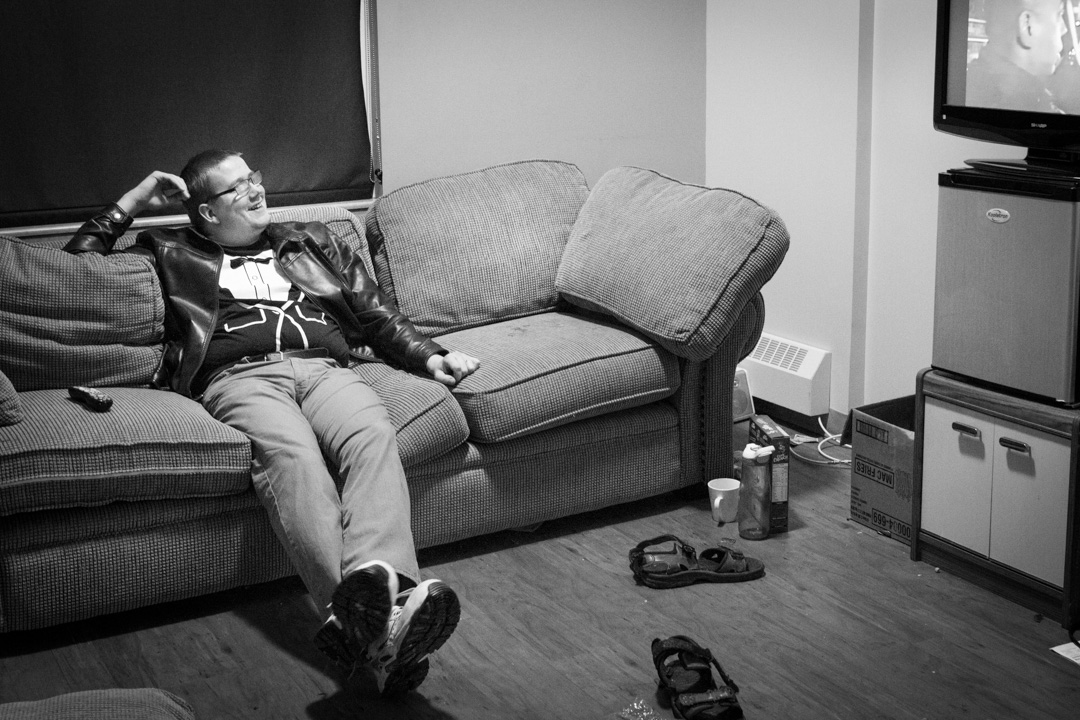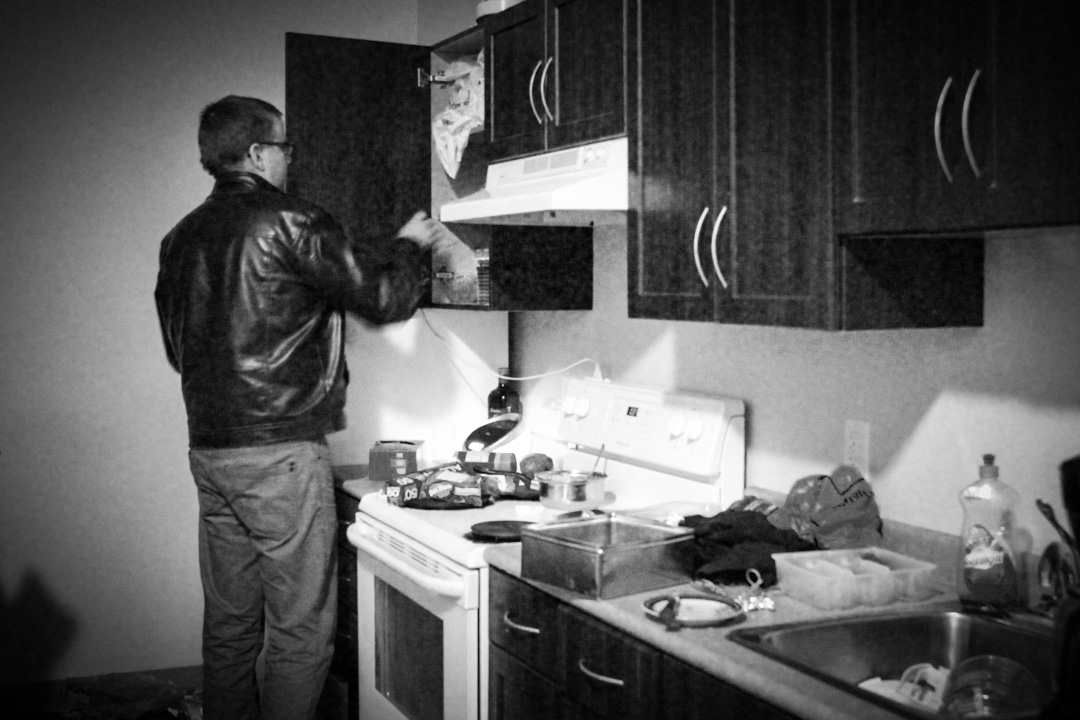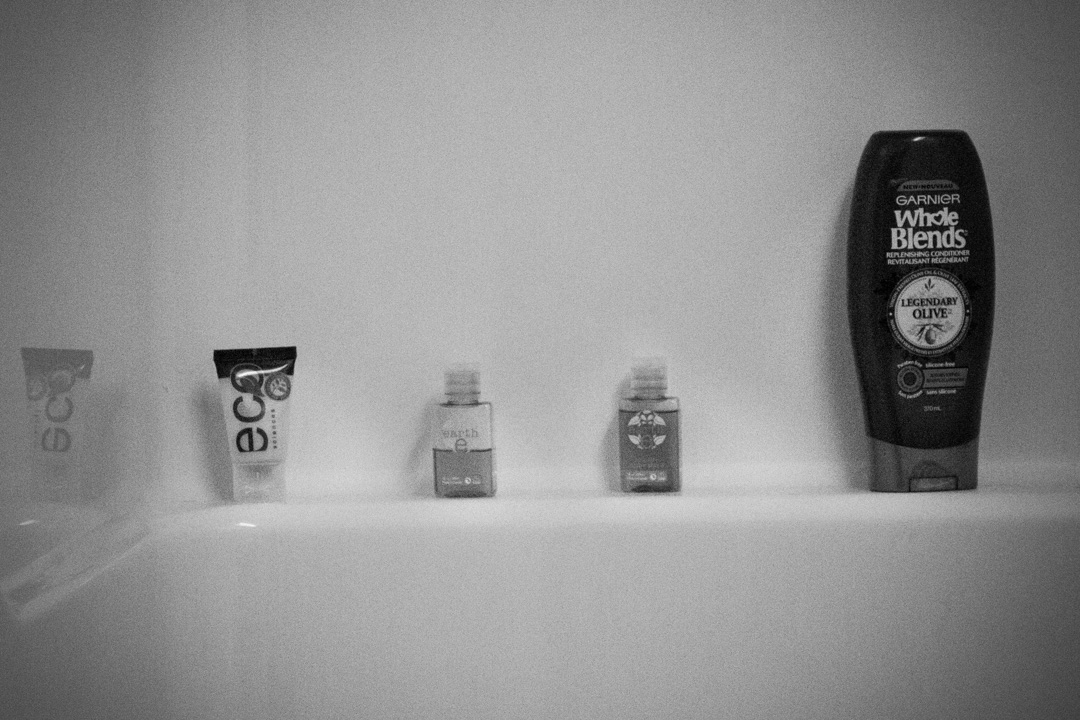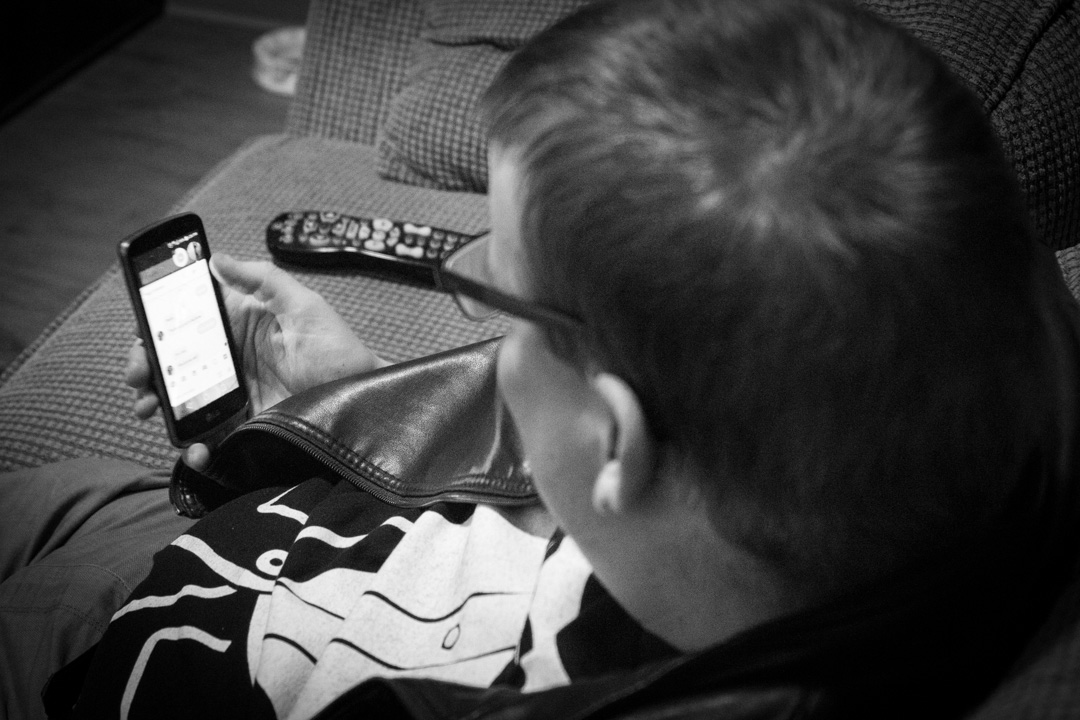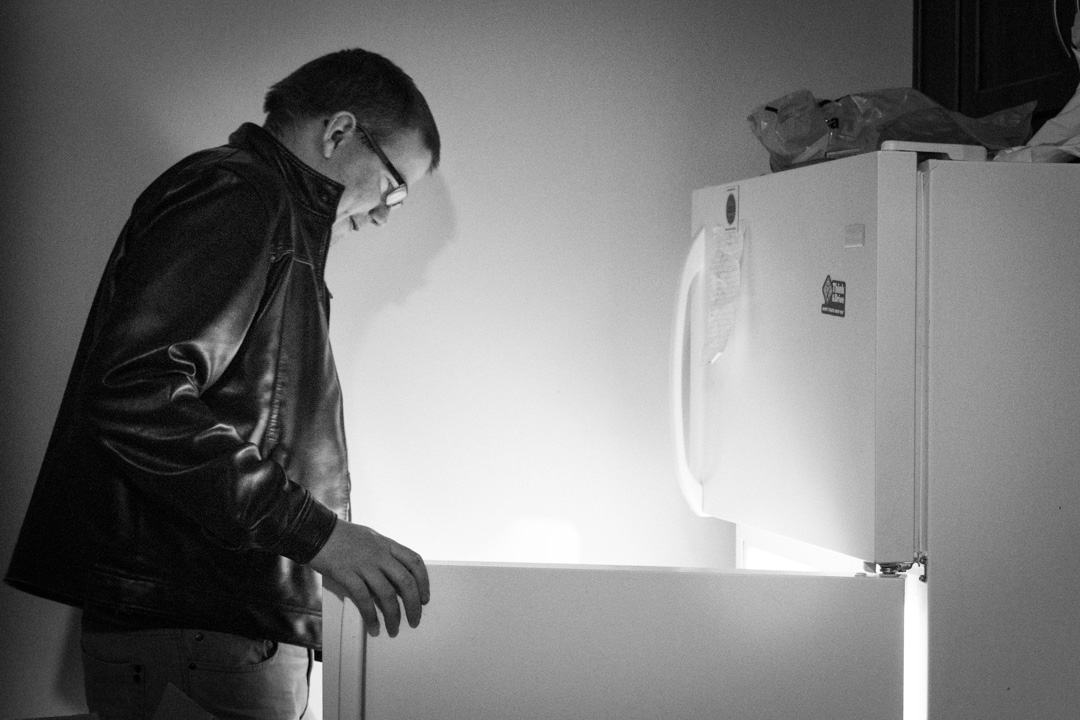Chapter 1:
Melcor
It sits on the corner of 95th street and 103a Avenue, an L-shaped building, kitty corner from a grey, cracked and stuccoed Edmonton Cash Register Company building. Across the street is an unpaved Impark lot and the Edmonton Police Service headquarters.
It’s in the heart of Boyle Street, an older neighbourhood adjacent to the downtown Edmonton corridor that sits in between Little Italy and Chinatown.
Square windows – without balconies – stack six rows high; a mix of white and grey concrete walls surround them. The building is flanked by glass enclosed staircases, one on each side. A city park space stretches a football field long from the back of the building. The grounds are peppered with trees, manicured walkways and park benches.
For anyone walking by it’s a new apartment building in a tired part of town.
But it’s more than that.
It’s a community. It’s Melcor. And for resident Benjamin Minor, it’s – finally – home.
Ben is waiting for me in the lobby as I pull up to Melcor. He runs outside to hold open the door; as I struggle with my bags and camera gear, Ben grabs one I’ve dropped.
“Lock your car!” he tells me before handing me a box of mint chocolates. “Help yourself,” he says, laughing under his breath. “I’ve already had too many.”
I’m here to see his apartment. At 26, it’s the first time he’s had a place he can call his own, and he tells me many times how happy he is, finally living by himself.
He scans his key card and we walk down the hall in silence. When we reach his door, he pauses and fumbles for his key.
“I haven’t had a chance to clean up,” he says as he’s unlocking the door. “I’m sorry for the mess.”
I assure him mine’s worse as he pushes open the door. And invites me in.
Ben has Fetal Alcohol Spectrum Disorder, a lifelong neurodevelopmental disability occurring from prenatal exposure to alcohol. It has no cure.
FASD affects no two people the same way. It’s an umbrella term describing a range of disabilities – physical, behavioural, mental and learning disabilities – that can occur in an individual whose mother drank during her pregnancy.
Ben’s spent his childhood in many different foster care and group homes. Because he’s grown up in Children’s Services, his records are sealed. Not many details are known about Ben’s life before he was dropped off on the doorstep – as a 17-year-old boy – of the Skills Society, a non-profit organization in Edmonton that supports people with disabilities, their families and communities. Operating in Edmonton since the early 1980’s, it believes individuals should have the opportunity to live full, contributing lives like every other person.
As an adult, Ben has had trouble with housing. He’s lived with a supportive roommate (which places him with a family) and in a group home. He’s spent time in respite housing (where individuals go when foster parents, families or guardians need a break). Unable to find the balance between support and independence, no housing situation’s been a good fit for Ben.
Until Melcor, that is.
Ben has lived at Melcor for nearly a year, and those who have known him before and after say moving into Melcor may have saved his life.
Connie Reid is an outreach worker at the Skills Society. She said he’s grown up; he needed more independence, and his previous housing situations weren’t giving him the supports and resources he needed to be successful.
“Benny’s had a really hard life,” said Reid, “but you wouldn’t believe the difference since living here.”
“It’s feeling taken care of, and accepted.”
The Melcor YMCA Village is a four-year-old affordable housing facility. The housing facility is one of three components (that includes the YMCA Shirley Stollery Child Care and the YMCA Family Resource Centre) belonging to the YMCA Welcome Village, aimed at providing a range of services in the community.
The YMCA of Northern Alberta and Capital Region Housing Corporation partnered with the City of Edmonton to build the village, which also includes the Boyle Renaissance Plaza, a modern, yellow community centre that houses the YMCA child care and family resource centre.
The YMCA built the complex after receiving a 20-year affordable housing grant from the city. As an affordable housing building, YMCA must maintain unit rental rates 10 to 15 per cent below the average market rate, set by the Canadian Mortgage and Housing Corporation’s yearly April data. The facility houses 148 operational apartment rooms ranging from two bedrooms to bachelor suites. All rooms are fully equipped with a kitchen and bathroom.
When designing the site, YMCA was deliberate about integrating other services, like the family resource centre, where people can go for assistance with things like bill payments and government subsidy, applications, and on-site staffing support, to provide more than a housing building.
“We think of housing as the roof,” said Joan Baker, vice president of Community and Housing Initiatives with the YMCA of Northern Alberta.
“But people need more than a roof.”
The Melcor tenants are a melting pot of Edmontonians; families, new immigrants, and low-income individuals all live in this diverse community.
According to Alec Johnston, program director at Melcor, the building is organized to give tenants the ability to maintain their lifestyle, live independently and succeed in life without the constant fear of losing housing.
Affordable housing buildings
Affordable housing is either rental or ownership housing that requires government money to build or operate. It has rents below average market cost and is usually occupied by people or families that earn less than median income for their household size. Affordable housing is one category offered on the housing spectrum, which varies in options from emergency shelters to home ownership.
According to the city, 20 per cent of Edmontonians can’t afford to rent or own their own homes, meaning many of those individuals are experiencing some sort of affordable housing issues. In 2011, more than 24,000 renters in Edmonton spent more than 50 per cent of their income on housing, which is an indication of severe affordable housing issues. The number of households on waitlists for affordable housing is currently estimated at more than 3,000.
Further, according to the same government database linked to in the above paragraph, Edmonton has more than 2,300 people living on the streets, according to the 2014 Government of Canada count on homelessness (although that’s a conservative estimate since many of the homeless population don’t ever access shelters or emergency services.) The city says it costs the government about $100,000 to support a high-risk individual (people who have a higher than average chance of being institutionalized, abusing drugs and alcohol, and being in a damaging relationship) living on the streets, in need of transitional housing or emergency level responses and support. By contrast, they say it costs $35,000 to provide that same person access to a safe and affordable housing living situation, a requirement for a stable and independent life.
Melcor as a Crime-Free Building
The Melcor building prides itself on being a Crime-Free Multi Housing program, a key criterion for moving in some of the high-risk individuals Skills Society supports.
As a crime-free building, not only must all tenants pass a criminal record police check, but they also must have a clean criminal record three to five years before they move in.
Melcor has a policy to not disclose the tenants’ identity. The building is accessible by key card only, each wing having its own card entrance.
For security reasons, bushes are trimmed to a certain height, outdoor and indoor lights must be a certain wattage, doors a certain width and locks a certain thickness.
All guests staying an extended length of time must be cleared by the building.
They have a zero-violence policy.
For Reid, the no-nonsense policy is good for their clients because it gives them responsibility they need as adults.
“There’s no fucking around,” she said.
Ben’s apartment is on the first floor of the Melcor building; his window – which opens only a few inches – looks out to the building’s parking. His unit is about the size of a small elementary school classroom, with a bathroom, a bedroom, and a kitchen that opens to the main living area. As he’s showing me around his home, he talks about things he’d like to eventually add to his apartment, when he has the money. A PlayStation is high on his wishlist. Like many bachelor pads, socks litter the bedroom floor and a toothpaste tube rests on the bathroom counter, but it’s a well-kept place (Melcor tenants must maintain a level of cleanliness and are subject to unit inspections). Ben shows me his fridge with orange juice and his cupboards with Captain Crunch. He’s most proud of his TV, where he watches his favourite shows like Criminal Minds and Cops. But unlike other homes, his walls are unadorned, his fridge free of magnets and cut-outs, and his bedside table bare.
It’s been years since Ben has seen his sister or his twin brother. His only contact is from his mom and dad (not his biological parents) who send him a Christmas card every year with one or two gift cards and a note that says “from mom and dad.”
He doesn’t talk about them much – any time I bring them up he becomes silent – bu het told me once over coffee and cheesecake how he wants to see them, because it’s been so long.
“It’s because I had issues”, he said.
